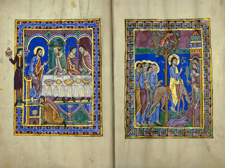Image
© Hildesheim, St Godehard |
CHRIST IN
THE HOUSE OF SIMON THE PHARISEE
Luke 7:36-50
Christ sits at the end of a long table, rebuking Simon the Pharisee and
pointing to Mary Magdalen below. She anoints his feet from an alabaster
jar and wipes them with her tears and hair. Behind Christ an attendant
enters bearing another jar. The assembled company are eating fish, not
the meat mentioned in Luke, and loaves, one of which is marked like the
sacrament. The tablecloth is particularly intricate, showing blue embroidery
and a white check damask pattern. It is the same meal and tablecloth as
the Last Supper, p41. This detail provides
a strong visual prompt that the scene serves as a prologue to the ensuing
Passion cycle.
Simon is incredulous that Christ should even allow the sinner Mary Magdalen
near him at table, while Christ, pointing to her, explains that her love
and penitence have brought forgiveness. The two others ask ‘Who
is this that forgives sins also?’
The attendant at the door is a conflation of two scenes: Mary arriving
and then washing the feet. Luke begins the episode with Mary Magdalen
coming to the house with the jar of ointment and standing behind Christ,
weeping. In Perpignan MS.1 and Admont, MS.289 the standing figure holding
the ointment is a second Magdalen, part of a continuous narrative (AP,
pl. 127a,b). Here she has been transformed into a genre figure, breaking
through the frame of the page.
The story above is taken directly from Luke 7:36-50, but its context and
meaning derive from the other gospels. In Matthew 26:6-12 and Mark 14:3-8,
the parallel scene involves a woman anointing Christ’s head not
his feet, and this provides an introduction to the Passion because Christ
says ‘She hath poured this ointment on my body, she did it for my
burial’. In John 12: 1-8, the washing of the feet is performed in
the house of Lazarus by Mary, the sister of Martha. Here there is no mention
of the preliminary scene, Mary bringing in the ointment, and the table
discussion is between Jesus and Judas, with no mention of the others’
comments. However, it is the John text (12: 12-15) which proceeds directly
to the Entry to Jerusalem, like the picture sequence in the St Albans
Psalter (p37). The repetition of the meal
and tablecloth both here and on p41 shows
that this link was deliberately intended.
Mary Magdalen provides a significant feminine frame to the Passion through
this scene and her subsequent annunciation of the Resurrection
to the apostles (p51) (Carrasco, 1999, 67-80). In a way, this scene
allows a woman the closest possible access to the Eucharist itself, the
culmination of Christian worship. Whereas the Last Supper scene (p41)
is a harsh depiction of betrayal and denial, this meal brings in the concept
of sacrifice and redemption through the intimate relationship between
Christ and Mary.
Like Mary Magdalen in this scene, Christina was humiliated and slandered,
accused of being a ‘loose woman’ but she nonetheless retained
her tactile intimacy with Christ (Talbot, 1998, 172-175, 118-9).
Quire 3. Thread or stitch holes for protective curtain

Click
to enlarge
|
![]()